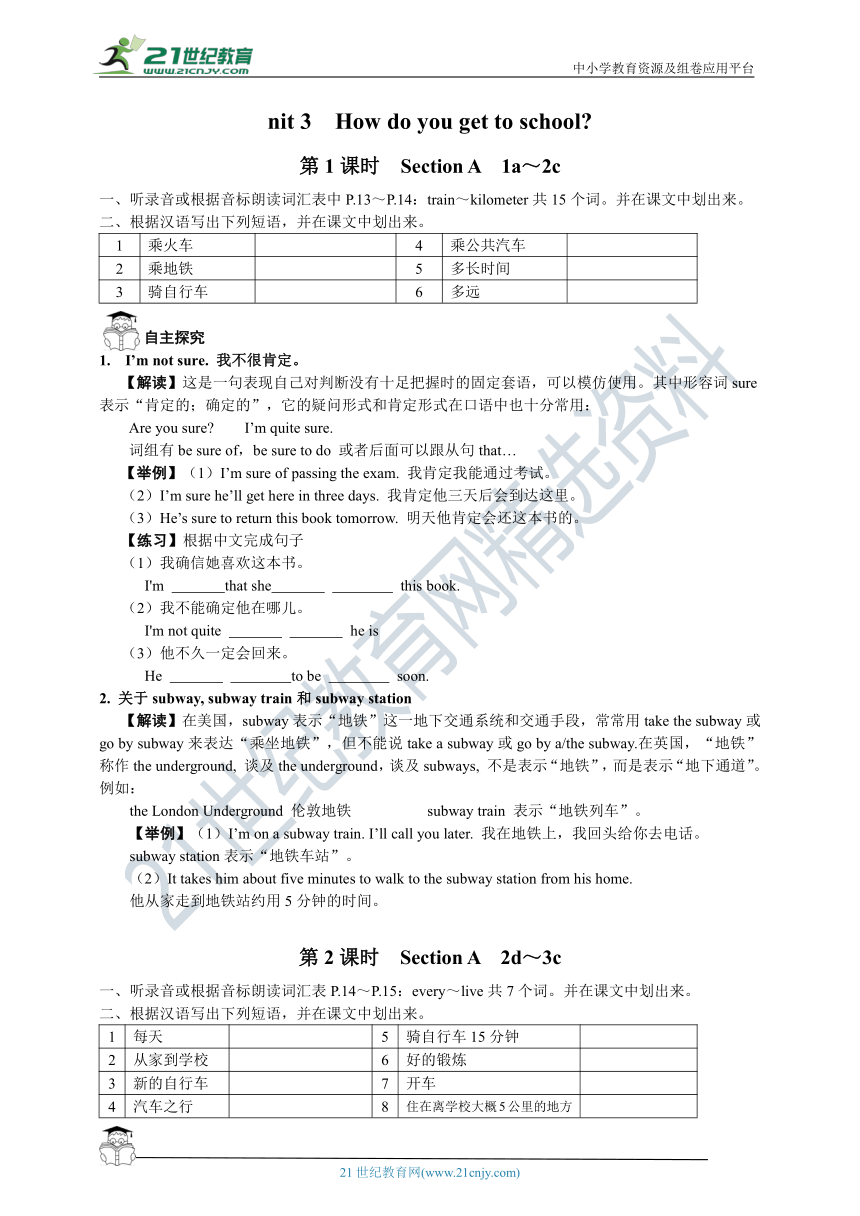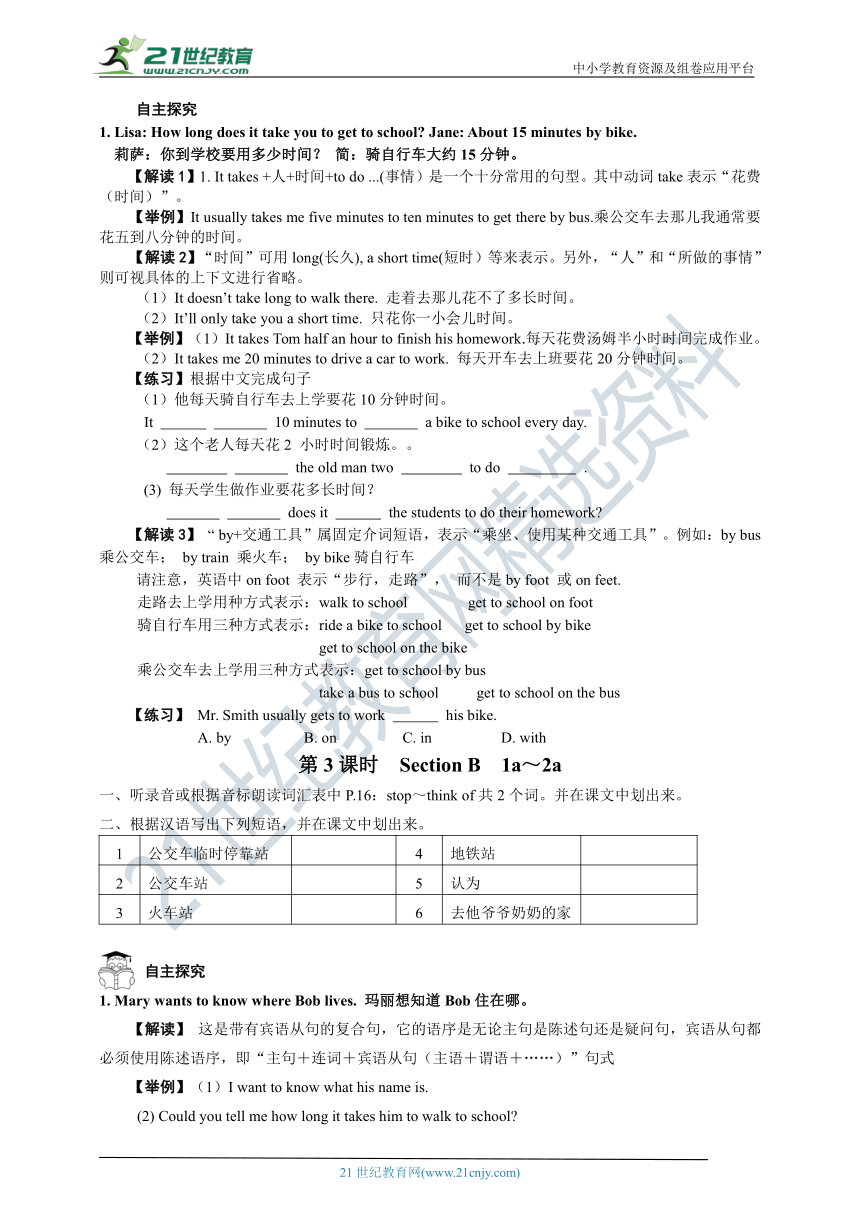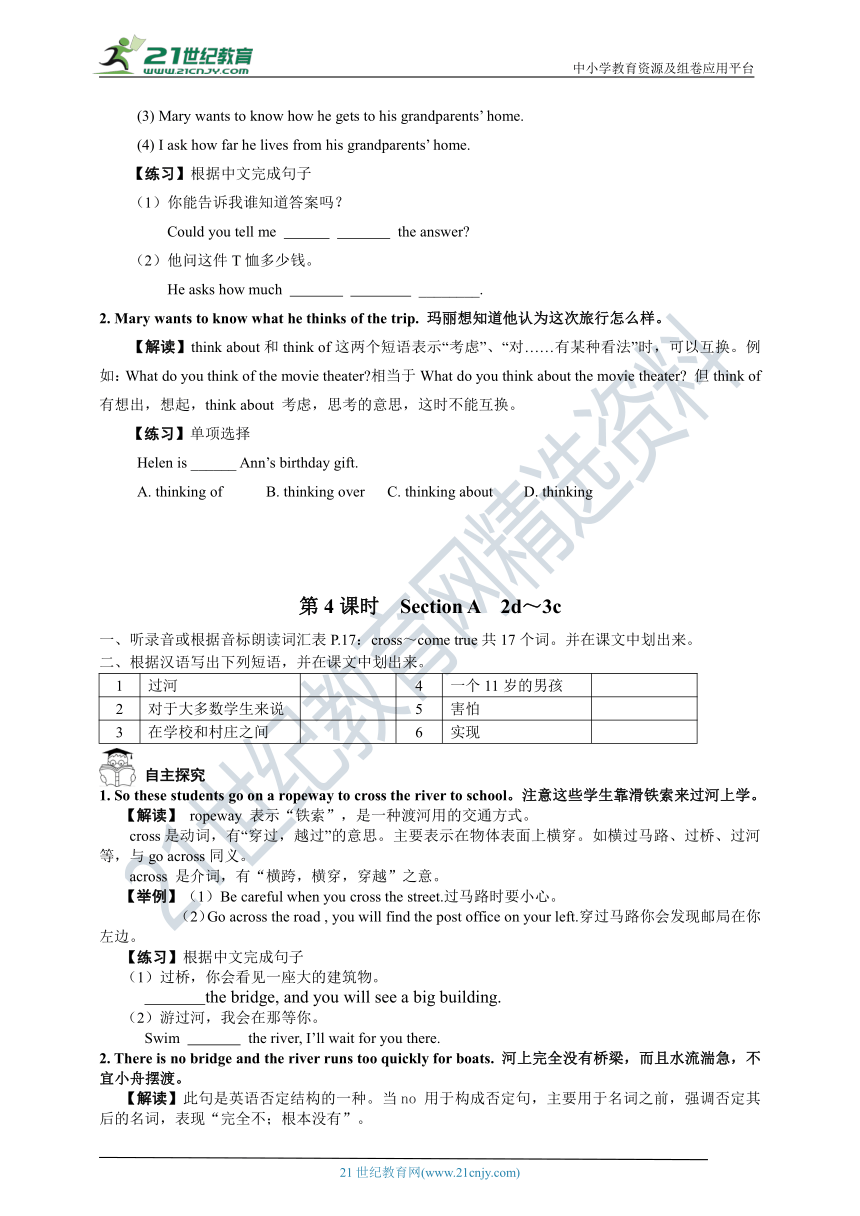Unit 3 How do you get to school? 单元同步学案(4课时 含答案)
文档属性
| 名称 | Unit 3 How do you get to school? 单元同步学案(4课时 含答案) |  | |
| 格式 | zip | ||
| 文件大小 | 1.2MB | ||
| 资源类型 | 试卷 | ||
| 版本资源 | 人教新目标(Go for it)版 | ||
| 科目 | 英语 | ||
| 更新时间 | 2020-08-17 21:54:13 | ||
图片预览



文档简介
中小学教育资源及组卷应用平台
nit
3
How
do
you
get
to
school?
第1课时
Section
A
1a~2c
一、听录音或根据音标朗读词汇表中P.13~P.14:train~kilometer共15个词。并在课文中划出来。
二、根据汉语写出下列短语,并在课文中划出来。
1
乘火车
4
乘公共汽车
2
乘地铁
5
多长时间
3
骑自行车
6
多远
自主探究
1.
I’m
not
sure.
我不很肯定。
【解读】这是一句表现自己对判断没有十足把握时的固定套语,可以模仿使用。其中形容词sure表示“肯定的;确定的”,它的疑问形式和肯定形式在口语中也十分常用:
Are
you
sure? I’m
quite
sure.
词组有be
sure
of,be
sure
to
do
或者后面可以跟从句that…
【举例】(1)I’m
sure
of
passing
the
exam.
我肯定我能通过考试。
(2)I’m
sure
he’ll
get
here
in
three
days.
我肯定他三天后会到达这里。
(3)He’s
sure
to
return
this
book
tomorrow.
明天他肯定会还这本书的。
【练习】根据中文完成句子
(1)我确信她喜欢这本书。
I'm
that
she
this
book.
(2)我不能确定他在哪儿。
I'm
not
quite
he
is
(3)他不久一定会回来。
He
to
be
soon.
2.
关于subway,
subway
train和subway
station
【解读】在美国,subway表示“地铁”这一地下交通系统和交通手段,常常用take
the
subway或go
by
subway来表达“乘坐地铁”,但不能说take
a
subway或go
by
a/the
subway.在英国,“地铁”称作the
underground,
谈及the
underground,谈及subways,
不是表示“地铁”,而是表示“地下通道”。例如:
the
London
Underground
伦敦地铁 subway
train
表示“地铁列车”。
【举例】(1)I’m
on
a
subway
train.
I’ll
call
you
later.
我在地铁上,我回头给你去电话。
subway
station表示“地铁车站”。
(2)It
takes
him
about
five
minutes
to
walk
to
the
subway
station
from
his
home.
他从家走到地铁站约用5分钟的时间。
第2课时
Section
A
2d~3c
一、听录音或根据音标朗读词汇表P.14~P.15:every~live共7个词。并在课文中划出来。
二、根据汉语写出下列短语,并在课文中划出来。
1
每天
5
骑自行车15分钟
2
从家到学校
6
好的锻炼
3
新的自行车
7
开车
4
汽车之行
8
住在离学校大概5公里的地方
自主探究
1.
Lisa:
How
long
does
it
take
you
to
get
to
school?
Jane:
About
15
minutes
by
bike.
莉萨:你到学校要用多少时间?
简:骑自行车大约15分钟。
【解读1】1.
It
takes
+人+时间+to
do
...(事情)是一个十分常用的句型。其中动词take表示“花费(时间)”。
【举例】It
usually
takes
me
five
minutes
to
ten
minutes
to
get
there
by
bus.乘公交车去那儿我通常要花五到八分钟的时间。
【解读2】“时间”可用long(长久),
a
short
time(短时)等来表示。另外,“人”和“所做的事情”则可视具体的上下文进行省略。
(1)It
doesn’t
take
long
to
walk
there.
走着去那儿花不了多长时间。
(2)It’ll
only
take
you
a
short
time.
只花你一小会儿时间。
【举例】(1)It
takes
Tom
half
an
hour
to
finish
his
homework.每天花费汤姆半小时时间完成作业。
(2)It
takes
me
20
minutes
to
drive
a
car
to
work.
每天开车去上班要花20分钟时间。
【练习】根据中文完成句子
(1)他每天骑自行车去上学要花10分钟时间。
It
10
minutes
to
a
bike
to
school
every
day.
(2)这个老人每天花2
小时时间锻炼。。
the
old
man
two
to
do
.
(3)
每天学生做作业要花多长时间?
does
it
the
students
to
do
their
homework?
【解读3】
“
by+交通工具”属固定介词短语,表示“乘坐、使用某种交通工具”。例如:by
bus
乘公交车;
by
train
乘火车;
by
bike骑自行车
请注意,英语中on
foot
表示“步行,走路”,
而不是by
foot
或on
feet.
走路去上学用种方式表示:walk
to
school
get
to
school
on
foot
骑自行车用三种方式表示:ride
a
bike
to
school
get
to
school
by
bike
get
to
school
on
the
bike
乘公交车去上学用三种方式表示:get
to
school
by
bus
take
a
bus
to
school
get
to
school
on
the
bus
【练习】
Mr.
Smith
usually
gets
to
work
his
bike.
A.
by
B.
on
C.
in
D.
with
第3课时
Section
B
1a~2a
一、听录音或根据音标朗读词汇表中P.16:stop~think
of共2个词。并在课文中划出来。
二、根据汉语写出下列短语,并在课文中划出来。
1
公交车临时停靠站
4
地铁站
2
公交车站
5
认为
3
火车站
6
去他爷爷奶奶的家
自主探究
1.
Mary
wants
to
know
where
Bob
lives.
玛丽想知道Bob住在哪。
【解读】
这是带有宾语从句的复合句,它的语序是无论主句是陈述句还是疑问句,宾语从句都必须使用陈述语序,即“主句+连词+宾语从句(主语+谓语+……)”句式
【举例】(1)I
want
to
know
what
his
name
is.
(2)
Could
you
tell
me
how
long
it
takes
him
to
walk
to
school?
(3)
Mary
wants
to
know
how
he
gets
to
his
grandparents’
home.
(4)
I
ask
how
far
he
lives
from
his
grandparents’
home.
【练习】根据中文完成句子
(1)你能告诉我谁知道答案吗?
Could
you
tell
me
the
answer?
(2)他问这件T恤多少钱。
He
asks
how
much
________.
2.
Mary
wants
to
know
what
he
thinks
of
the
trip.
玛丽想知道他认为这次旅行怎么样。
【解读】think
about和think
of这两个短语表示“考虑”、“对……有某种看法”时,可以互换。例如:What
do
you
think
of
the
movie
theater?相当于What
do
you
think
about
the
movie
theater?
但think
of有想出,想起,think
about
考虑,思考的意思,这时不能互换。
【练习】单项选择
Helen
is
______
Ann’s
birthday
gift.
A.
thinking
of
B.
thinking
over
C.
thinking
about
D.
thinking
第4课时
Section
A
2d~3c
一、听录音或根据音标朗读词汇表P.17:cross~come
true共17个词。并在课文中划出来。
二、根据汉语写出下列短语,并在课文中划出来。
1
过河
4
一个11岁的男孩
2
对于大多数学生来说
5
害怕
3
在学校和村庄之间
6
实现
自主探究
1.
So
these
students
go
on
a
ropeway
to
cross
the
river
to
school。注意这些学生靠滑铁索来过河上学。
【解读】
ropeway
表示“铁索”,是一种渡河用的交通方式。
cross是动词,有“穿过,越过”的意思。主要表示在物体表面上横穿。如横过马路、过桥、过河等,与go
across同义。
across
是介词,有“横跨,横穿,穿越”之意。
【举例】(1)Be
careful
when
you
cross
the
street.过马路时要小心。
(2)Go
across
the
road
,
you
will
find
the
post
office
on
your
left.穿过马路你会发现邮局在你左边。
【练习】根据中文完成句子
(1)过桥,你会看见一座大的建筑物。
the
bridge,
and
you
will
see
a
big
building.
(2)游过河,我会在那等你。
Swim
the
river,
I’ll
wait
for
you
there.
2.
There
is
no
bridge
and
the
river
runs
too
quickly
for
boats.
河上完全没有桥梁,而且水流湍急,不宜小舟摆渡。
【解读】此句是英语否定结构的一种。当no
用于构成否定句,主要用于名词之前,强调否定其后的名词,表现“完全不;根本没有”。
(1)There
are
no
computers
in
that
small
mountain
village.
在那个小山村里根本就没有电脑。
(2)There
is
no
milk
in
the
fridge.
冰箱里没有牛奶。
【练习】
单项选择
There
is
homework
today.
A.
not
B.
no
C.
no
any
D.
not
some
3.
One
11-year-old
boy,
Liangliang,
crosses
the
river
every
school
day.
亮亮,一个11岁的男孩,每天过河上学。
【解读】11-year-old构成一个复合形容词,修饰名词boy.请注意其中的year之后没有复数词尾-s。这一结构较为常见。例如:a
four-day
trip一个四天的旅行
a
30-page
book一本30页的书
a
three-room
house一栋三间屋的房子
【练习】单项选择
There
is
80-year-old
woman
in
the
house.
A.
a
B.
an
C.
the
D.
\
参考答案:
Unit
3
How
do
you
get
to
school?
第1课时
Section
A
1a~2c
二、短语理解
1.
take
the
train
2.
take
the
subway
3.
ride
a
bike
4.take
the
bus
5.
how
long
6.
how
far
自主探究
1.
(1)
sure,
will
like
(2)
sure,
where
(3)
is
sure,
back
第2课时
Section
A
2d~3c
二、短语理解
1.
every
day
2.
from
home
to
school
3.
a
new
bike
4.
bus
ride
5.
15minutes
by
bike
6.
good
exercise
7.
drive
a
car
8.
live
about
5
kilometers
from
school
自主探究
1.
(1)
takes
him,
ride
(2)
It
takes,
hours,
exercise
(3)
How
long,
take
2.
B
第3课时
Section
B
1a~2a
二、短语理解
1.
bus
stop
2.
bus
station
3.
train
station
4.
subway
station
5.
think
of
6.
go
to
his
grandparents’
home
自主探究
1.
(1)
who,
knows
(2)
the
T-shirt,
is
2.
C
第4课时
Section
A
2d~3c
二、短语理解
1.
cross
the
river
2.
for
many
students
3.
between
the
school
and
the
village
4.
an
11-year-old
boy
5.
be
afraid
6.
come
true
自主探究
1.
(1)
Cross
(2)
across
2.
B
3.
B
21世纪教育网
www.21cnjy.com
精品试卷·第
2
页
(共
2
页)
HYPERLINK
"http://21世纪教育网(www.21cnjy.com)
"
21世纪教育网(www.21cnjy.com)
nit
3
How
do
you
get
to
school?
第1课时
Section
A
1a~2c
一、听录音或根据音标朗读词汇表中P.13~P.14:train~kilometer共15个词。并在课文中划出来。
二、根据汉语写出下列短语,并在课文中划出来。
1
乘火车
4
乘公共汽车
2
乘地铁
5
多长时间
3
骑自行车
6
多远
自主探究
1.
I’m
not
sure.
我不很肯定。
【解读】这是一句表现自己对判断没有十足把握时的固定套语,可以模仿使用。其中形容词sure表示“肯定的;确定的”,它的疑问形式和肯定形式在口语中也十分常用:
Are
you
sure? I’m
quite
sure.
词组有be
sure
of,be
sure
to
do
或者后面可以跟从句that…
【举例】(1)I’m
sure
of
passing
the
exam.
我肯定我能通过考试。
(2)I’m
sure
he’ll
get
here
in
three
days.
我肯定他三天后会到达这里。
(3)He’s
sure
to
return
this
book
tomorrow.
明天他肯定会还这本书的。
【练习】根据中文完成句子
(1)我确信她喜欢这本书。
I'm
that
she
this
book.
(2)我不能确定他在哪儿。
I'm
not
quite
he
is
(3)他不久一定会回来。
He
to
be
soon.
2.
关于subway,
subway
train和subway
station
【解读】在美国,subway表示“地铁”这一地下交通系统和交通手段,常常用take
the
subway或go
by
subway来表达“乘坐地铁”,但不能说take
a
subway或go
by
a/the
subway.在英国,“地铁”称作the
underground,
谈及the
underground,谈及subways,
不是表示“地铁”,而是表示“地下通道”。例如:
the
London
Underground
伦敦地铁 subway
train
表示“地铁列车”。
【举例】(1)I’m
on
a
subway
train.
I’ll
call
you
later.
我在地铁上,我回头给你去电话。
subway
station表示“地铁车站”。
(2)It
takes
him
about
five
minutes
to
walk
to
the
subway
station
from
his
home.
他从家走到地铁站约用5分钟的时间。
第2课时
Section
A
2d~3c
一、听录音或根据音标朗读词汇表P.14~P.15:every~live共7个词。并在课文中划出来。
二、根据汉语写出下列短语,并在课文中划出来。
1
每天
5
骑自行车15分钟
2
从家到学校
6
好的锻炼
3
新的自行车
7
开车
4
汽车之行
8
住在离学校大概5公里的地方
自主探究
1.
Lisa:
How
long
does
it
take
you
to
get
to
school?
Jane:
About
15
minutes
by
bike.
莉萨:你到学校要用多少时间?
简:骑自行车大约15分钟。
【解读1】1.
It
takes
+人+时间+to
do
...(事情)是一个十分常用的句型。其中动词take表示“花费(时间)”。
【举例】It
usually
takes
me
five
minutes
to
ten
minutes
to
get
there
by
bus.乘公交车去那儿我通常要花五到八分钟的时间。
【解读2】“时间”可用long(长久),
a
short
time(短时)等来表示。另外,“人”和“所做的事情”则可视具体的上下文进行省略。
(1)It
doesn’t
take
long
to
walk
there.
走着去那儿花不了多长时间。
(2)It’ll
only
take
you
a
short
time.
只花你一小会儿时间。
【举例】(1)It
takes
Tom
half
an
hour
to
finish
his
homework.每天花费汤姆半小时时间完成作业。
(2)It
takes
me
20
minutes
to
drive
a
car
to
work.
每天开车去上班要花20分钟时间。
【练习】根据中文完成句子
(1)他每天骑自行车去上学要花10分钟时间。
It
10
minutes
to
a
bike
to
school
every
day.
(2)这个老人每天花2
小时时间锻炼。。
the
old
man
two
to
do
.
(3)
每天学生做作业要花多长时间?
does
it
the
students
to
do
their
homework?
【解读3】
“
by+交通工具”属固定介词短语,表示“乘坐、使用某种交通工具”。例如:by
bus
乘公交车;
by
train
乘火车;
by
bike骑自行车
请注意,英语中on
foot
表示“步行,走路”,
而不是by
foot
或on
feet.
走路去上学用种方式表示:walk
to
school
get
to
school
on
foot
骑自行车用三种方式表示:ride
a
bike
to
school
get
to
school
by
bike
get
to
school
on
the
bike
乘公交车去上学用三种方式表示:get
to
school
by
bus
take
a
bus
to
school
get
to
school
on
the
bus
【练习】
Mr.
Smith
usually
gets
to
work
his
bike.
A.
by
B.
on
C.
in
D.
with
第3课时
Section
B
1a~2a
一、听录音或根据音标朗读词汇表中P.16:stop~think
of共2个词。并在课文中划出来。
二、根据汉语写出下列短语,并在课文中划出来。
1
公交车临时停靠站
4
地铁站
2
公交车站
5
认为
3
火车站
6
去他爷爷奶奶的家
自主探究
1.
Mary
wants
to
know
where
Bob
lives.
玛丽想知道Bob住在哪。
【解读】
这是带有宾语从句的复合句,它的语序是无论主句是陈述句还是疑问句,宾语从句都必须使用陈述语序,即“主句+连词+宾语从句(主语+谓语+……)”句式
【举例】(1)I
want
to
know
what
his
name
is.
(2)
Could
you
tell
me
how
long
it
takes
him
to
walk
to
school?
(3)
Mary
wants
to
know
how
he
gets
to
his
grandparents’
home.
(4)
I
ask
how
far
he
lives
from
his
grandparents’
home.
【练习】根据中文完成句子
(1)你能告诉我谁知道答案吗?
Could
you
tell
me
the
answer?
(2)他问这件T恤多少钱。
He
asks
how
much
________.
2.
Mary
wants
to
know
what
he
thinks
of
the
trip.
玛丽想知道他认为这次旅行怎么样。
【解读】think
about和think
of这两个短语表示“考虑”、“对……有某种看法”时,可以互换。例如:What
do
you
think
of
the
movie
theater?相当于What
do
you
think
about
the
movie
theater?
但think
of有想出,想起,think
about
考虑,思考的意思,这时不能互换。
【练习】单项选择
Helen
is
______
Ann’s
birthday
gift.
A.
thinking
of
B.
thinking
over
C.
thinking
about
D.
thinking
第4课时
Section
A
2d~3c
一、听录音或根据音标朗读词汇表P.17:cross~come
true共17个词。并在课文中划出来。
二、根据汉语写出下列短语,并在课文中划出来。
1
过河
4
一个11岁的男孩
2
对于大多数学生来说
5
害怕
3
在学校和村庄之间
6
实现
自主探究
1.
So
these
students
go
on
a
ropeway
to
cross
the
river
to
school。注意这些学生靠滑铁索来过河上学。
【解读】
ropeway
表示“铁索”,是一种渡河用的交通方式。
cross是动词,有“穿过,越过”的意思。主要表示在物体表面上横穿。如横过马路、过桥、过河等,与go
across同义。
across
是介词,有“横跨,横穿,穿越”之意。
【举例】(1)Be
careful
when
you
cross
the
street.过马路时要小心。
(2)Go
across
the
road
,
you
will
find
the
post
office
on
your
left.穿过马路你会发现邮局在你左边。
【练习】根据中文完成句子
(1)过桥,你会看见一座大的建筑物。
the
bridge,
and
you
will
see
a
big
building.
(2)游过河,我会在那等你。
Swim
the
river,
I’ll
wait
for
you
there.
2.
There
is
no
bridge
and
the
river
runs
too
quickly
for
boats.
河上完全没有桥梁,而且水流湍急,不宜小舟摆渡。
【解读】此句是英语否定结构的一种。当no
用于构成否定句,主要用于名词之前,强调否定其后的名词,表现“完全不;根本没有”。
(1)There
are
no
computers
in
that
small
mountain
village.
在那个小山村里根本就没有电脑。
(2)There
is
no
milk
in
the
fridge.
冰箱里没有牛奶。
【练习】
单项选择
There
is
homework
today.
A.
not
B.
no
C.
no
any
D.
not
some
3.
One
11-year-old
boy,
Liangliang,
crosses
the
river
every
school
day.
亮亮,一个11岁的男孩,每天过河上学。
【解读】11-year-old构成一个复合形容词,修饰名词boy.请注意其中的year之后没有复数词尾-s。这一结构较为常见。例如:a
four-day
trip一个四天的旅行
a
30-page
book一本30页的书
a
three-room
house一栋三间屋的房子
【练习】单项选择
There
is
80-year-old
woman
in
the
house.
A.
a
B.
an
C.
the
D.
\
参考答案:
Unit
3
How
do
you
get
to
school?
第1课时
Section
A
1a~2c
二、短语理解
1.
take
the
train
2.
take
the
subway
3.
ride
a
bike
4.take
the
bus
5.
how
long
6.
how
far
自主探究
1.
(1)
sure,
will
like
(2)
sure,
where
(3)
is
sure,
back
第2课时
Section
A
2d~3c
二、短语理解
1.
every
day
2.
from
home
to
school
3.
a
new
bike
4.
bus
ride
5.
15minutes
by
bike
6.
good
exercise
7.
drive
a
car
8.
live
about
5
kilometers
from
school
自主探究
1.
(1)
takes
him,
ride
(2)
It
takes,
hours,
exercise
(3)
How
long,
take
2.
B
第3课时
Section
B
1a~2a
二、短语理解
1.
bus
stop
2.
bus
station
3.
train
station
4.
subway
station
5.
think
of
6.
go
to
his
grandparents’
home
自主探究
1.
(1)
who,
knows
(2)
the
T-shirt,
is
2.
C
第4课时
Section
A
2d~3c
二、短语理解
1.
cross
the
river
2.
for
many
students
3.
between
the
school
and
the
village
4.
an
11-year-old
boy
5.
be
afraid
6.
come
true
自主探究
1.
(1)
Cross
(2)
across
2.
B
3.
B
21世纪教育网
www.21cnjy.com
精品试卷·第
2
页
(共
2
页)
HYPERLINK
"http://21世纪教育网(www.21cnjy.com)
"
21世纪教育网(www.21cnjy.com)
同课章节目录
- Unit 1 Can you play the guitar?
- Section A
- Section B
- Unit 2 What time do you go to school?
- Section A
- Section B
- Unit 3 How do you get to school?
- Section A
- Section B
- Unit 4 Don't eat in class.
- Section A
- Section B
- Unit 5 Why do you like pandas?
- Section A
- Section B
- Unit 6 I'm watching TV.
- Section A
- Section B
- Review of Units 1-6
- Unit 7 It's raining!
- Section A
- Section B
- Unit 8 Is there a post office near here?
- Section A
- Section B
- Unit 9 What does he look like?
- Section A
- Section B
- Unit 10 I'd like some noodles.
- Section A
- Section B
- Unit 11 How was your school trip?
- Section A
- Section B
- Unit 12 What did you do last weekend?
- Section A
- Section B
